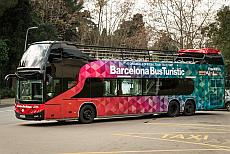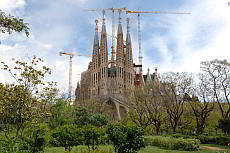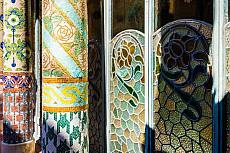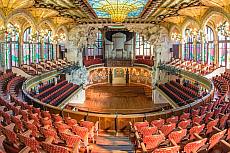Palau de la Música Catalana
Discover the fascinating concert hall - part of the UNESCO World Heritage
The concert hall is a masterpiece by the architect Lluís Domènech i Montaner - alongside Antoni Gaudí one of the most important representatives of modernism. The concert hall of the music palace is impressive.
Content of this page
The builder of the Palau de la Música was the Catalan choir association "Orfeó Català", founded in 1891. Construction began in 1905 and the Music Palace was inaugurated in 1908.
The Palau de la Música Catalana has been on the UNESCO World Heritage List since 1997. The concert hall is one of the most beautiful in the world.
Tickets to enter the Palau
- Explore the Palau on your own: You can move around freely and listen to the explanations and music of the audio guide or take in the impressive interior of the Palau.
- Admission to the Palau de la Música Catalana
- Audio guide to download to your smartphone with explanations, images, music and videos (QR code provided on site)
- Audio guide in Englisch, French, Spanish, Catalan
- Ticket also on the smartphone
- Immediate ticket delivery
- Duration: approx. 50 minutes
- Admire Lluís Domènech i Montaner's detailed Art Nouveau masterpiece
- During the tour, the guide will tell you interesting and exciting things about the Palau. You can also ask questions here.
- Live guide in English, French, Spanish, Italian
- Admission to the Palau de la Música Catalana
- Ticket also on the smartphone
- Immediate ticket delivery
- Duration: approx. 55 minutes
The Palau de la Musica Catalana
The rapid development of Catalonia towards the end of the 19th century produced a well-to-do bourgeoisie that was looking for new forms of self-expression. Modernisme became an essential means of expression for this aspiring bourgeoisie.
Lluís Domènech i Montaner
With the first modernist building, the "Castell dels tres Dragons", the architect Lluís Domènech i Montaner is now considered the founder of modernism.

The central element of Modernisme is the merging of different art forms - such as sculpture, blacksmithing, ceramics and glass art - as well as different architectural styles. This can be clearly seen in many places in the Palau de la Música.
The architect of the Palau de la Música was Lluís Domènech i Montaner, the founder and one of the most important representatives of Modernisme. At that time he was the most renowned architect in Barcelona.
The "Orfeó Català", an amateur music society founded in 1891, was very popular in Barcelona around the turn of the century. They wanted to create a special setting for their own performances and those of other artists. Money for the construction came from donations from wealthy merchants and industrialists, and none other than the star architect Domènech i Montaner was hired.
Construction began in 1905 and the inauguration in 1908.
According to Lluís Domènech i Montaner, the Palau de la Música Catalana should be a "garden for music". It is worth immersing yourself in its "musical garden" and being enchanted by the wealth of detail in this extraordinary building.
In the 1980s, the Palau de la Música Catalana was remodeled and modernized under the direction of architect Óscar Tusquets, without losing its original charm.
The facade
The facade is richly adorned with mosaic pillars, each one with a different floral design. Busts of great masters such as Beethoven, Bach and Wagner bear witness to the prevailing taste in music at the time. On one corner is a sculpture dedicated to the Catalan folk song and ruled by the patron saint of Catalonia, Sant Jordi. Elements from the Gothic and Moorish architectural styles have also been incorporated into the design of the facade.
Big concert hall
One of the most distinctive concert halls in the world - the Concert Auditorium - has been the privileged setting for national and international musical life in the city of Barcelona for more than a hundred years.
The stage is dominated by an organ, which can be heard again after a restoration in 2004. The auditorium is a mystical and paradoxical hall full of characters like the 16 muses surrounding the stage playing different musical instruments from different countries and regions. They symbolize the different styles of music and embody the spirit of the Palau de la Música Catalana - a performance venue where every genre of music should find its place.
To the left and right of the stage are two other imposing sculptures, a bust of Anselm Clavé on one side and a bust of Beethoven on the other. These symbolize folk and classical music.
A lot of glass makes the music palace very bright and gives it a very special atmosphere. Light shines through stained glass windows and a central skylight, a downward-curving, glass and colorful dome symbolizing the sun.
The auditorium is filled with natural light.
The decorative elements made of ceramics with natural forms are also typical of Modernisme: a number of natural motifs such as flowers, palm trees or fruits adorn the room.
Rehearsal room of the Orfeó Català
The little jewel of the Palau de la Música is the Sala d'Assaig de l'Orfeó Català, the rehearsal room of the Orfeó Català. A cosy, intimate place for concerts, lectures, small-scale presentations – and of course the place where the Orfeó Català choirs practice. The foundation stone of the Palau de la Música was also laid here. The hall has sturdy columns, stained glass and a decoration typical of Catalan modernism.
Petit Palau
Another venue that the Palau has is the Petit Palau: a modern auditorium that opened in 2004 and is ideal for chamber music or small-scale concerts. It has excellent acoustics and high-tech audiovisual equipment.
Lluís Millet Room
Another very special part of the Palau is the Sala Lluís Millet, a meeting place during breaks dedicated to Maestro Millet, founder of the Orfeó Català. The hall is two stories high, with large stained glass windows decorated with floral designs, creating an extraordinary effect. Even more extraordinary is the balcony seen through these windows, with its double colonnade decorated with distinctive colors and ornaments.
Foyer
Another exceptional place is the foyer of the Palau, which can accommodate a large number of people both during performances and as a separate restaurant-cafeteria. The wide arches of brick and green ceramics glazed with floral patterns give this area a distinctive atmosphere.
What music is played
Which music genres are played in the Palau de la Música is easy to answer: "Every kind of music is played in the Palau de la Música - except operas, because these are shown in the Gran Teatre del Liceu". This is how visitors experience it during a guided tour. However, this statement is not 100% correct: it does happen that an opera is on the program, but very rarely.
The program for the 2022/23 season includes, for example, flamenco, classical music during the "Bachcelona" festival, Mozart's Requiem with the Orfeó Català choir, classical during the Mozart festival, Vivaldi's Four Seasons, music by Hans Zimmer & John Williams, Spanish guitar music , Ballet Swan Lake, Jazz, Abba Tribute, Pop Music, Beatles+Queen+ABBA, Haydn, Beethoven & Widmann - played by Anne-Sophie Mutter and much more.
World-famous artists, but also unknown talents perform here.
Why a visit to the Palau de la Música is worthwhile
The building is simply impressive and imposing. This is where Modernisme shows itself from its most beautiful side, the Palau is truly one of the most beautiful works of Catalan Art Nouveau. Treat yourself to a short break in the foyer of the concert hall. The cafe is quite cozy and nice.
Book tickets for the Palau de la Música here
(Click on the product images to view prices and availability)
Important information
Surroundings
Find Hotels nearby
Address
Palau de la Música, 4-6
Arrival
Metro: Urquinaona (L1, L4)
Bus Turístic: Barri Gòtic
Parking nearby
Opening times
Visits: 09.30 - 15.30
Café restaurant: daily 09.00 - 24.00
Tips for the visit of the Palau de la Música
Plan about 1.5 hours for the visit.
Please note that there is no cloakroom or lockers.
If you want to attend a concert, we recommend booking the tickets in advance.
Book your accommodation in Barcelona here! All categories.
1-5*-hotel rooms, apartments, hostels.








